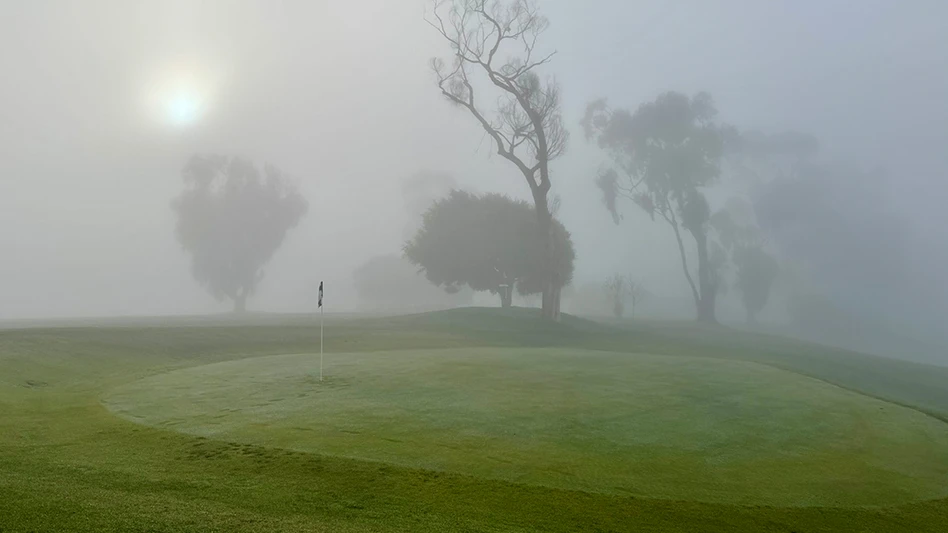 There is a plethora of abiotic causes for poor turfgrass quality, including traffic stress, compaction, improper fertility, incorrect use of pesticides, shade, poor drainage, too much or too little water, high temperature (especially soil temperature), cold injury, and other factors. And all of these issues are one big headache for superintendents who must deal with them on their course’s playing surfaces.
There is a plethora of abiotic causes for poor turfgrass quality, including traffic stress, compaction, improper fertility, incorrect use of pesticides, shade, poor drainage, too much or too little water, high temperature (especially soil temperature), cold injury, and other factors. And all of these issues are one big headache for superintendents who must deal with them on their course’s playing surfaces.
“They are widespread. I have seen abiotic issues across the country,” says Dr. Lee Miller, extension turfgrass pathologist at the University of Missouri. Black layer, heat stress, drought stress, shade stress, too much moisture, mechanical damage, layering of sand-based putting greens are some of the many problems in turfgrass systems and actually from the perspective of our diagnostic lab they significantly outnumber biotic problems of turfgrass systems.”
Common abiotic disorders associated with winter include deicing salt injury, crown hydration, winterkill or low temperature kill, and desiccation. Some of the common abiotic disorders during the growing season include oversaturated soils, compaction, wear, drought, wet wilt, nutrient deficiency or toxicity, and chemical phytotoxicity.
“In our turfgrass diagnostic lab, approximately 50 to 60 percent of the damage in received samples are caused by abiotic disorders and not the result of an infectious disease,” Miller says.
“The No. 1 abiotic disorder we observe in our diagnostic clinic is an oversaturated rootzone,” he adds. “This condition can be caused by over irrigation or too much organic matter, which acts like a sponge and holds the water. Add a bit of heat or physiological stress onto a creeping bentgrass green with a saturated soil condition, and decline can occur very rapidly. We use the acronym SHRS, or soggy hot root syndrome, to describe this decline.”
|
What is it? According to Dr. Brad Fresenburg, assistant extension professor with the University of Missouri’s Division of Pant Sciences, the keys to distinguishing between abiotic problems and biotic problems are as follows:
|
Other than oxygen deprivation in a pore-filled rootzone, a variety of factors can result in decline. For example, water resiliently holds onto its temperature, so once the soil solution heats up, it takes an extended duration or level of cool temperatures to bring it back down. Secondly, fungal pathogens such as pythium root rot thrive in a waterlogged soil, and appreciate the resultant weakened and compromised root tissue to infect. Soil nutrients and beneficial aerobic microflora also may be diluted in a flooded soil profile, so nutrient availability for turfgrass health, defense or recovery may be limiting.
Abiotic causes for turfgrass problems can be widespread, and many times they are mistaken as biotic causes, such as turfgrass diseases, says Dr. Brad Fresenburg, assistant extension professor with the University of Missouri’s Division of Pant Sciences.
“So if we look at the weather, extreme heat (high soil temps reduce root mass) or cold (extreme cold temps can cause winter desiccation of warm-season grasses like Bermudagrass and zoysiagrass) can have an impact on turfgrass quality,” Fresenburg says.
Too much rain (saturated soils reduce soil oxygen and reduce nutrient uptake) versus too little rain (leads to wilting and dormancy) are abiotic. Imbalances of nutrients in the soil can cause symptoms of nutrient deficiencies and slow growth. Ice salt, chemical spills (such as gasoline), misapplications of pesticides, underground gas leaks, animal urine and shade from trees are all abiotic causes to poor quality turfgrasses, since all have an impact on the normal growth of that plant on a continuous basis.
In addition, poor cultural practices for turfgrass management can also be considered abiotic. Mowing too close or scalping the turf can produce poor quality. Lack of soil testing and improper fertilization can lead to nutrient imbalances. Lack of aeration or soil cultivation can lead to compacted soils therefore reducing root mass and leading to a weak plant being more susceptible to drought. Lack of or too much irrigation can have the same impacts as too much rain or too little rain.
Richard Buckley, coordinator of the Plant Diagnostic Laboratory at Rutgers University, believes many researchers and superintendents think of abiotic stress in terms of physical (temperature and moisture extremes), chemical (problems with pesticides, fertilizers, and other plant health care products), and mechanical (traffic, scalping, etc).
“I also like to think of damage from abiotic causes in terms of the weather, site condition and infrastructure, and people problems,” he says. “In our laboratory, we diagnose about 38 percent of our samples with abiotic stress. Temperature and moisture stress – extremes hot/cold and dry/wet – or some combination of both cause most of the problems.”
Some abiotic stresses are site-specific, related to management practices or events at that location, says Dr. Megan Kennelly, associate professor at Kansas State University’s Department of Plant Pathology. Others are more widespread, such as winter injury across a whole region, or summer decline from hot, humid conditions across a large area.
For example, 2010 was a hot, humid summer in Kansas and many other states and hot, water-saturated soils led to wide scale turf decline, Kennelly says. In contrast, 2012 was a major drought in many places, and water quantity and quality issues were a big story that year.
“In early spring we see a lot of areas are with some cold damage as the grasses are greening up,” he says. “During hot, stressful summers there can be abiotic decline across large areas.”
Abiotic turfgrass problems can develop into specific patches and symptoms that may mimic root diseases.
“There are numerous instances when we look at a turf sample that has symptoms that resemble a root disease such as take-all patch, pythium root rot, or Bermudagrass decline, but after examination we cannot find enough of the causal organism to conclude a disease has truly developed,” Kennelly says. “Plus we also look at the soil structure, rooting, salt accumulation and with all of that data plus a record from the golf course superintendent, we conclude that something abiotic is the main cause of the problem.”
Turfgrass is a very dynamic system with an abundance of microbial activity. Most if not all common turf pathogens are present in soil samples, Kearns says, but turf managers have to make a judgment call on when the symptoms, the signs of the organism (and the amount) and environmental conditions are correct for a disease.”
“The disease triangle is a fundamental concept in plant pathology that states that a virulent pathogen, a susceptible host and a conducive environment must come together in a specific point in time in order for disease to develop,” Kearns says. “Thus, disease is actually a relatively rare event in nature. Since golfers demand a monoculture and certain playing conditions, golf course superintendents are required to manage their playing surfaces on the verge of death, essentially. Therefore abiotic and biotic problems plague golf course turfgrass. The key is developing a good relationship with a diagnostic lab that can help managers distinguish between abiotic and biotic problems.”
If a crew member burns the grass with a pesticide or hydraulic fluid there will be an unmistakable pattern. Temperature and moisture stress, however, are often non-descript and manifest as general yellowing and thinning, both symptoms used to describe any number of diseases.
Determining the root cause of damage on putting greens or any turfgrass area can be challenging. Plant symptoms often look very similar, and a superintendent should be wary of advice coming solely from a “six-foot” (or standing height) perspective.
The first step is to ask: What is different about this green or area from others that look fine? Is there more water or is it not draining well? Was there a product misapplication? Is it shaded or tucked in the corner?
Secondly, look for patterns. Damage caused by an infectious disease is often randomly scattered across an area, and most diseases can only infect or are more aggressive on one turfgrass species (bentgrass vs. Poa annua) as opposed to another. Also, infectious diseases normally don’t occur in straight lines, which is a stand symptom indicative of an equipment leak or chemical misapplication. Lastly, get a diagnostic visit, send or take a sample to your local turfgrass pathologist.
|
Helpful hints Richard Buckley, coordinator of the Plant Diagnostic Laboratory at Rutgers University, provides some additional helpful hints to diagnose abiotic stress in your turf.
“Careful observations of your site, the weather, and your treatment effects will tell you what happened -- just open up to the possibilities……and use a professional for help,” he says. |
To determine what may be going on with your turf is to document symptoms with photos or try to see patterns. “The key to diagnosing many odd abiotic possibilities is to ask questions about what may have been done recently cultural practices, pesticide applications, weather information,” Dr. Fresenburg says. “Sometimes those actions can point a finger to the cause and you can remedy the problem.”
Buckley believes diagnosing abiotic stress amounts to “proving the negative.” The turf should be carefully examined for disease and insect pests. Once they are ruled out, evaluate cause and effect. “What was the recent weather? Did we do anything to the grass? Is the irrigation system functioning, sprayer calibrated, mower set up right, etc. With an abiotic stress the cause and effect is usually clear if one is honest about the current conditions. Think `it was 100-degree on Tuesday, what did I miss?’ or, `I you put nine products in the tank, what do I expect?”’
Diagnosing turf problems – both abiotic and biotic – can be tricky, Kennelly says. When in doubt, it is best to work with a diagnostic lab. Sign up for newsletters, blogs, and social media from your region’s turf specialists who can tell you what is going on in your area.
“However, a few key pointers are to look for patterns in space and time,” Kennelly says. “Diseases are more likely to start in one area and then get worse over time.” Abiotic issues are more likely to be “all at once.” But, there is still a lot of variation. “Think about the weather conditions and what sorts of stresses or diseases could be occurring. Consider any activities at the golf course over the past few weeks – has there been anything unusual? What has the weather been? Taking photos and notes over the time can help you keep track of when/where issues started. This can be valuable within one season and from year-to-year.”
John Torsiello is a Torrington, Conn.-based writer and frequent GCI contributor.

Explore the May 2014 Issue
Check out more from this issue and find your next story to read.
Latest from Golf Course Industry
- Beyond the Page 65: New faces on the back page
- From the publisher’s pen: New? No way!
- Indiana course upgrades range with synthetic ‘bunkers’
- Monterey Peninsula CC Shore Course renovation almost finished
- KemperSports and Touchstone Golf announce partnership
- PBI-Gordon Company hires marketing manager Jared Hoyle
- Mountain Sky Guest Ranch announces bunker enhancement project
- GCSAA names Joshua Tapp director of environmental programs






